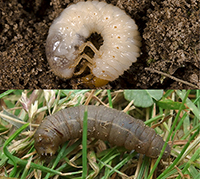Pest Population Management

Pest Population Management
It was widely believed the different conditions that favoured chafer grubs and leatherjackets meant course managers would typically only encounter one of them at a time.
However, discussions at BTME revealed over a quarter of greenkeepers had experienced problems caused by both pest species.
Most managed golf courses create artificial conditions that can make areas more attractive to both species of pests. Parkland courses with naturally wetter soils, typically conductive to leatherjackets, may artificially drain and lighten sand-based green making them attractive to chafer grubs too. Irrigation on links green could also create conditions to favour leatherjackets.
Allied to that, changing climatic trends have blurred to historic east/west split that historically saw chafers more prevalent in the east and leatherjackets more common in the west.
Changes in weather patterns – and the adapting life-cycle of insects – have certainly complicated predicting pest activity. Last season the intense heat and dry conditions appeared to delay the emergence of crane fly – for up to a month later than the July and August norm. Crane fly were even reported emerging and on the wing in October, making it difficult to target control of resulting larvae.
The unusually dry and hot summer also led to irrigated areas being far more attractive to breeding chafer bugs, leading to higher larvae populations in those areas than previously experienced.
Milder winter months appear to have led to grubs feeding at much higher levels than in cold Years, leaving turf surfaces far more prone to damage from foraging animals.
The difference in the life cycles of each species has an impact on their turf effects and efforts to minimise damage. The garden chafer, for example, goes through its entire life-cycle in on season – from egg laying, through all larval stages, cockchafer larvae live and feed in the soil for three years to go through the same process.
IPM programmes
Knowing the different species cycle and emergence timing in crucial if any Integrated Pest Management (IPM) programme and control application timing is to be successful.
Where conditions are suitable for natural insects, we have seen they adapt remarkably quickly and move to colonise new areas. The huge egg laying capability of insects means that only a few adults can result in large numbers of larvae under favourable conditions.
When other food sources are limited, some predators will search out and feed at relatively low pest populations. A hungry badger may seek out grub s in turf that appears unaffected by larvae feeding, resulting in extensive economic damage. The damage done by predators at low grub population levels far exceed the damage done by the actual grub itself.
Attack recovery
Over the past summer, the evidence of root loss from larvae feeding was especially severe, leaving turf more susceptible to intense drought effects. Any measures to enhance root mass can help mitigate the effects of damage, including soil moisture managements. Primo Maxx PGR and nutrition.
Alleviating stress on turf plants during hot, sunny conditions becomes even more important at a time when root mass is typically reducing over the summer. Then, in the autumn, it becomes essential to maintain nutrition and conditions for root recovery.
Where the populations of larvae can be minimised. Through IPM measures and seasonal control of larvae in soil when available, it gives better chance for turf plants to recover; reduces the risk of predators seeking out food and lowers pressure from reinfestation each year.
Soil pest impacts
Both chafer grubs and leatherjackets cause damage to turf through the larvae feeding on roots, which can be severe in localised patches. Leatherjackets in particular often occur in concentrated areas, leading to yellowing turf and die back.
Subterranean tunnelling of pests will result in dangerously poor stability for sports and racecourse surfaces. Turf that is under stress or with poor rooting can be especially affected, and become more susceptible to drought and disease.
However, the most extreme damage can occur when badgers, birds and other pest predators root through turf in search of the grubs. Heavy rain, mild temperatures and irrigation can encourage larvae activity close to the surface and more attractive to predators.